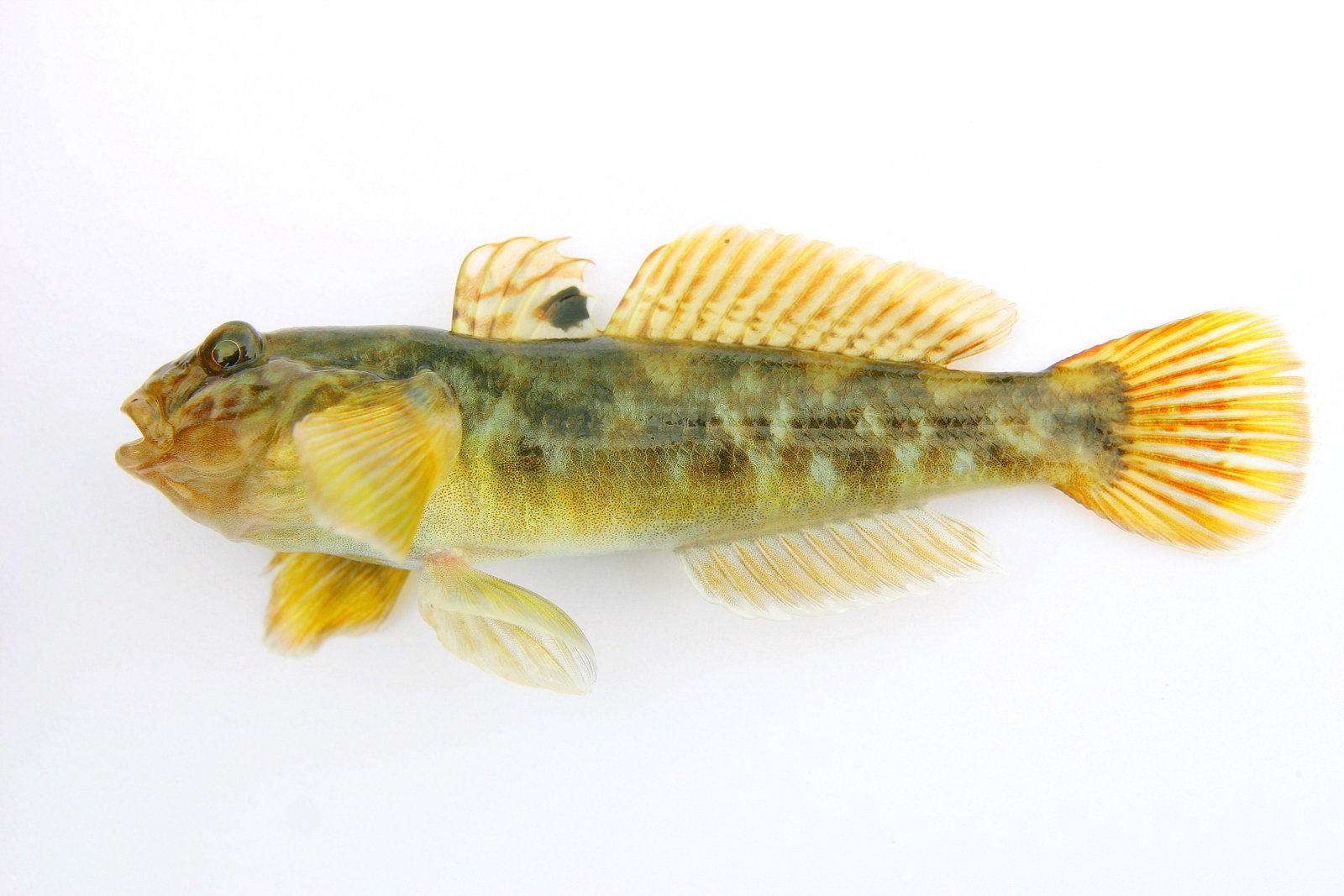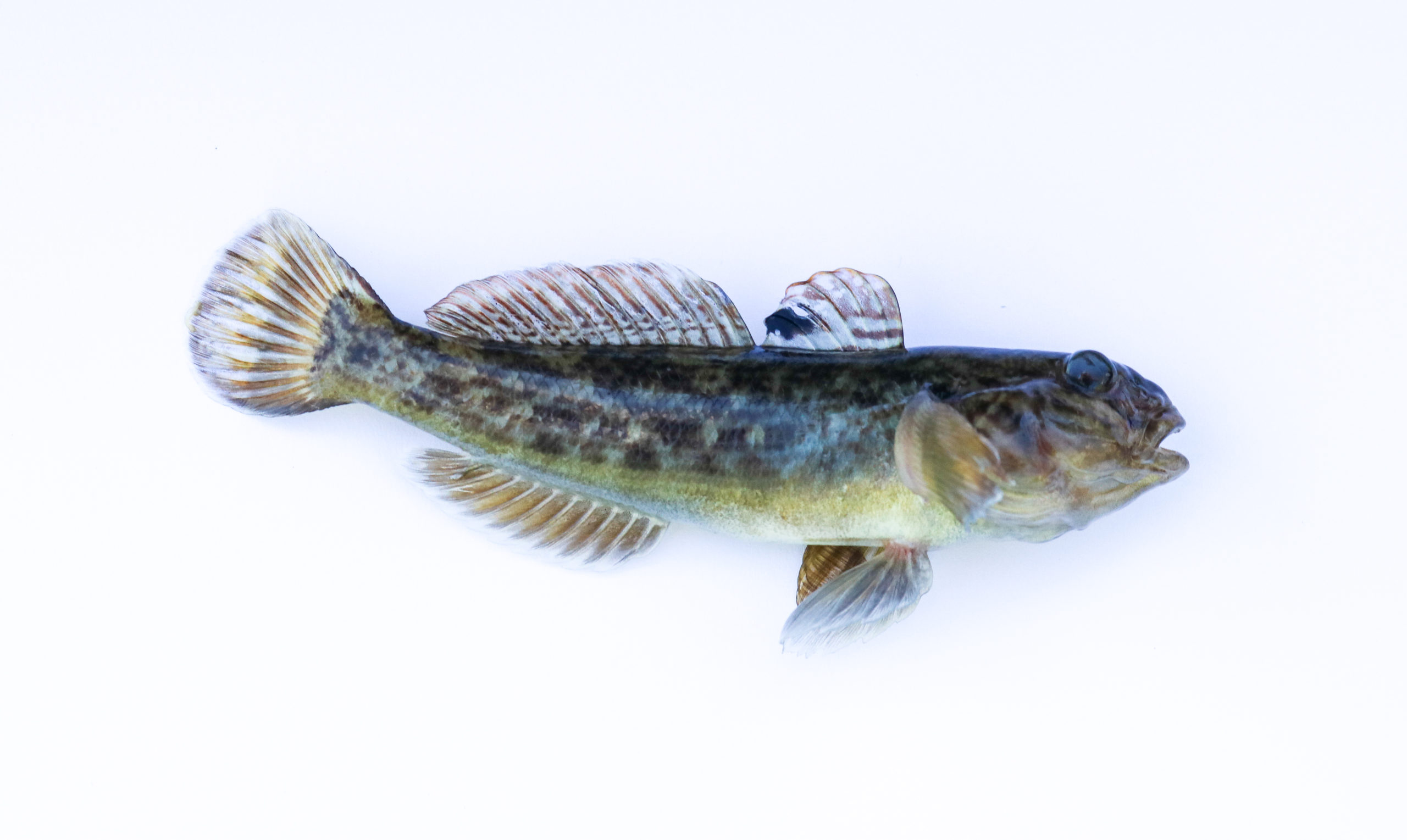Round goby
Gobiidae
Gobies are members of one of the largest existing fish families, the order Gobiiformes, hosting more than 2,000 species – a very big family!
There is a large number of goby species in Romania, of which the ‘stronghillii’ (Neogobius melanostomus) are the most numerous. They are mostly found at the mouths of the Danube, but they can also be found in the Black Sea.
Other famous species are Neogobius kessleri, Neogobius gymnotrachelus, Neogobius fluviatilis, Ponticola eurycephalus.
Most of gobiid fish are relatively small, typically less than 10 cm. Some large gobies can reach over 30 cm in length, but that is exceptional. Generally, they are bottom-dwellers. The main characteristic of gobies is the fact that the ventral fins of the fish are united into one, which helps in fixing them on the bottom of the water. As a result the water currents don’t affect them much. The head is relatively rounded, slightly flattened, the muzzle is short, and the eyes are small. The mouth is large, wide, with a prominent mandibular region and fleshy lips.
Most gobies feed on small invertebrates, although some of the larger species eat other fish, and a few eat planktonic algae.
Gobiids have great commercial importance for countries arund the Black Sea, particularly Ukraine and Russia.

Photographer: Peter van der Sluijs

Photographer: Peter van der Sluijs
Guvizii fac parte din una dintre cele mai mari familii de pești existente, ordinul Gobiiformelor, găzduind mai mult de 2.000 de specii – o familie foarte mare!
Există un număr mare de specii de guvizi în România, dintre care ‘stronghillii’ (Neogobius melanostomus) sunt cei mai numeroși. Sunt întâlniți în principal la gurile Dunării, dar pot fi găsiți și în Marea Neagră. Alte specii faimoase sunt Neogobius kessleri, Neogobius gymnotrachelus, Neogobius fluviatilis, Ponticola eurycephalus.
Majoritatea guvizilor sunt relativ mici, în general mai puțin de 10 cm. Unii pot ajunge la peste 30 cm lungime, dar acest lucru este excepțional. În general locuiesc la fundul apei. Caracteristica principală gobiiformelor este faptul că înotătoarele adbominale din față ale peștilor sunt unite într-una singură, ceea ce îi ajută să se fixeze pe fundul apei. Ca rezultat, curenții de apă nu îi afectează prea mult. Capul este relativ rotunjit, ușor aplatizat, botul este scurt, iar ochii sunt mici. Gura este mare, largă, cu o regiune mandibularăfoarte evidentă și buze cărnoase. Majoritatea guvizilor se hrănesc cu nevertebrate mici, deși unele dintre speciile mai mari consumă alți pești, iar câteva mănâncă alge plancton.
Guvizii au o mare importanță comercială pentru țările din jurul Mării Negre, în special Ucraina și Rusia.
Guvid
Gobiidae
Rundgrundel
Gobiidae
Die Grundeln gehören zu einer der größten Fischfamilien, der Ordnung der Gobiiformes, die mehr als 2.000 Arten beherbergt – eine sehr große Familie!
In Rumänien gibt es eine große Anzahl von Grundelarten, von denen die “Stronghillii” (Neogobius melanostomus) die zahlreichsten sind. Man findet sie vor allem in den Mündungen der Donau, aber auch im Schwarzen Meer. Andere bekannte Arten sind Neogobius kessleri, Neogobiusn gymnotrachelus, Neogobius fluviatilis und Ponticola eurycephalus.
Die meisten Grundeln sind relativ klein, in der Regel weniger als 10 cm. Einige große Grundeln können eine Länge von über 30 cm erreichen, aber das ist die Ausnahme. Im Allgemeinen sind sie Bodenbewohner. Das Hauptmerkmal der Grundeln ist die Tatsache, dass die Bauchflossen der Fische zu einer einzigen Flosse vereinigt sind, was dazu beiträgt, dass sie am Boden des Wassers festsitzen.
Dadurch werden sie von den Wasserströmungen kaum beeinträchtigt. Der Kopf ist relativ rund, leicht abgeflacht, die Schnauze ist kurz, und die Augen sind klein. Das Maul ist groß, breit, mit einem ausgeprägten Unterkieferbereich und fleischigen Lippen. Die meisten Grundeln ernähren sich von kleinen wirbellosen Tieren, einige der größeren Artenfressen jedoch auch andere Fische, und einige wenige ernähren sich von planktischen Algen.
Grundeln sind für die Anrainerstaaten des Schwarzen Meeres, insbesondere die Ukraine und Russland, von großer wirtschaftlicher Bedeutung

Photographer: Peter van der Sluijs

Photographer: Peter van der Sluijs
Les gobies à taches noires font partie de l’une des plus grandes familles de poissons existantes, l’ordre des Gobiiformes, abritant plus de 2 000 espèces – une très grande famille !
Il existe un grand nombre d’espèces de gobies en Roumanie, dont les ‘stronghillii’ (Neogobius melanostomus) sont les plus nombreux. On les trouve principalement aux embouchures du Danube, mais on les trouve également dans la Mer Noire. D’autres espèces célèbres sont Neogobius kessleri, Neogobius gymnotrachelus, Neogobius fluviatilis, Ponticola eurycephalus.
La plupart des poissons gobie sont relativement petits, généralement moins de 10 cm. Certains grands gobies peuvent atteindre plus de 30 cm de longueur, mais c’est exceptionnel. Généralement, ce sont des habitants du fond. La principale caractéristique des gobies est le fait que les nageoires ventrales du poisson sont réunies en une seule, ce qui aide à les fixer au fond de l’eau. En conséquence, les courants d’eau ne les affectent pas beaucoup. La tête est relativement arrondie, légèrement aplatie, le museau est court et les yeux sont petits. La bouche est grande, large, avec une région mandibulaire proéminente et des lèvres charnues.
La plupart des gobies se nourrissent de petits invertébrés, bien que certaines des plus grandes espèces mangent d’autres poissons et quelques-unes mangent des algues planctoniques.
Gobies
Gobiidae
Try using these colors:
Remember, there are always more colors than you think you see!







